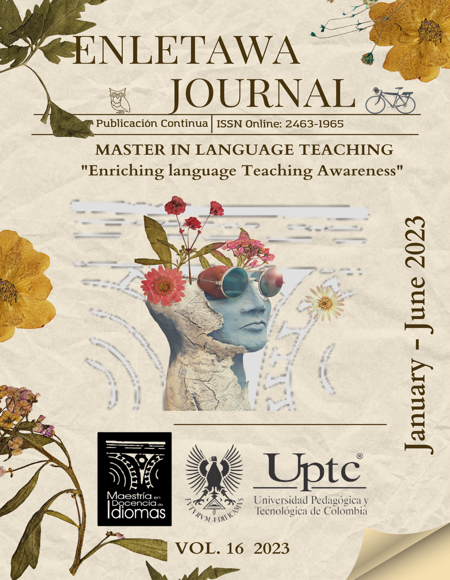Hyperdoc’ing a Legal English Lesson. My First Experience with Hyperdocs

Abstract
This article provides an overview of a group of students’ first experience with HyperDocs as a strategy to foster learning English as a Foreign Language (EFL). It then presents students’ insights on their learning experience along with comments and reflections made by their teacher over the process of implementing HyperDocs in a Legal English course at a Colombian private university. This qualitative study involved a focus group, a students’ survey and the students’ artifacts. The findings display the relevance of assisting students in taking control of their own learning process, being critical net surfers and taking advantage of online learning resources.
Keywords
legal English, TEFL, HyperDocs
Author Biography
Yomaira Angélica Herreño Contreras
She Holds a B.A in Modern Languages (Universidad Surcolombiana), a M.A in Comparative Literature and Literary Translation (Universidad Pompeu Fabra). Currently, she is a Ph.D. candidate in Comparative Literature (University of Auckland)
References
- Agustina, T. (2014). English for specific purposes (ESP): an approach of English
- teaching for non-English department students. Beta, 7 (1), 37-63.
- Bergmann, J., & Sams, A. (2012). Flip your classroom. Reach every student in
- every class every day. International Society for Technology in Education.
- Carpenter, J., Trust, T., & Green, T. (2020). Transformative instruction or old wine
- in new skins? Exploring how and why educators use HyperDocs. Computers & Education, 57,1-19. https://doi.org/10.1016/j.compedu.2020.103979. DOI: https://doi.org/10.1016/j.compedu.2020.103979
- CAST (2018). Universal Design for Learning Guidelines version 2.2.
- http://udlguidelines.cast.org
- Creswell, J. W. (2012). Educational research: Planning, conducting, and evaluating quantitative and qualitative research (4th ed.). Pearson
- Edmunds, H., NetLibrary, Inc, & American Marketing Association. (1999). The
- focus group research handbook. Lincolnwood, Ill.: NTC Business Books.
- Flipped Learning Network. (2014). Definition of flipped learning.
- http://www.flippedlearning.org/domain/46
- Highfill, L., Hilton, K., & Landis, S. (n.d.). The HyperDoc handbook study guide.
- https://bit.ly/3gKVh1H.
- Lage, M. J., Platt, G. J., & Treglia, M. (2000). Inverting the classroom: A gateway to
- creating an inclusive learning environment. The Journal of Economic Education, 31(1), 30-43.
- Ramírez, M., & Rodríguez-Buitrago, C. (2018). In-Class Flip in Teacher Education
- Through Loop-Input. In H. Castañeda (Ed.). Technology in ELT: achievements and challenges for ELT development (pp.131-147). Universidad Distrital Francisco José de Caldas.
- https://die.udistrital.edu.co/sites/default/files/doctorado_ud/publicaciones/technology_in_elt_achievements_and_challenges_for_elt_development.pdf#page=131
- Rodríguez-Buitrago, C. (2021). HyperDocs for Language Teaching, Building
- Autonomy in Learners while Recognizing Their Humanness. In Y.A Herreño-Contreras. (Ed.). TEFL practices. Scenarios for Research and Reflection (69-85). Ediciones USTA.
- Zadra, C. (2014). Schooling and Lifelong Learning. The Role of Transversal Key
- Competences. Procedia - Social and Behavioral Sciences,116, 4727-4731.
- https://doi.org/10.1016/j.sbspro.2014.01.1016 DOI: https://doi.org/10.1016/j.sbspro.2014.01.1016
